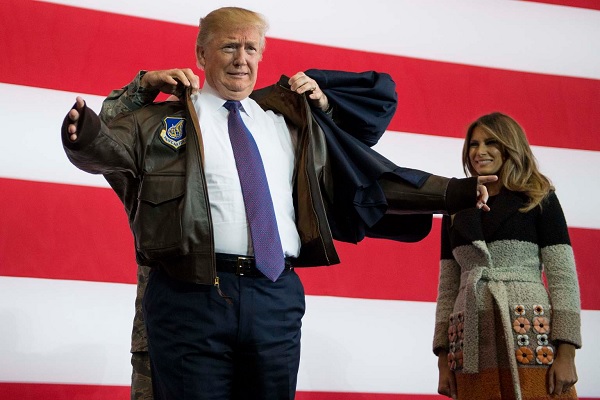The president promised to deliver peace. But in his first year, he expanded every war he inherited.

Back in March, U.S. Secretary of State Rex Tillerson defended his proposed slashing of the Foreign Operations Budget by 31 percent on the grounds that, “As time goes by, there will be fewer military conflicts that the U.S. will be directly engaged in.” A few weeks ago, he made an even more expansive claim, saying that, “Bringing the budget numbers back down is reflective of an expectation that we’re going to have success in some of these conflict areas, getting these conflicts resolved.”
Needless to say, Tillerson’s aspirations — that the United States will be involved in fewer wars and deliver greater peace — have not been achieved. In reality, the Donald Trump administration has demonstrated no interest in reducing America’s military commitments and interventions, nor committed itself in any meaningful way to preventing conflicts or resolving them. Moreover, as 2017 wraps up, the trend lines are actually running in the opposite direction, with no indication that the Trump administration has the right membership or motivation to turn things around.
President Trump has maintained or expanded the wars that he inherited from his predecessor.
As Jennifer Wilson and I pointed out in an appropriately titled column in August, “Donald Trump Is Dropping Bombs at Unprecedented Levels.” Within eight months of assuming office, Trump — with the announcement of six “precision aistrikes” in Libya — had bombed every country that former President Barack Obama had in eight years. One month after that, the United States surpassed the 26,172 bombs that had been dropped in 2016. Through the end of December 2017, Trump had authorized more airstrikes in Somalia in one year (33), than George W. Bush and Obama had since the United States first began intervening there in early 2007 (30).
The growth in airstrikes was accompanied by a more than proportional increase in civilian deaths, which Azmat Khan and Anand Gopal documented in the most impressive work of investigative journalism that I read this year, as well as the killing of militant fighters. In July, Gen. Tony Thomas, head of U.S. Special Operations Command, claimed “in conservative estimates 60,000 to 70,000” Islamic State fighters had been killed in Iraq and Syria. In 2014, just after the war began, the CIA claimed that the Islamic State could “muster between 20,000 and 31,500 fighters.” The fact that the United States more than doubled the size of its enemy in pursuit of defeating it on the battlefield — for the time being — should lead to a re-examination of U.S. counterterrorism strategies.
But as the volume of airstrikes and deaths increased, the Trump administration has subsequently made no progress in winding down America’s wars. Moreover, it doesn’t even pretend that the United States should play any role in supporting diplomatic outcomes. For example, in the U.S.-backed air war in Yemen, Secretary of Defense James Mattis has stated, “Our aim is that this crisis can be handed to a team of negotiators under the aegis of the United Nations.” Of all parties to the conflict, the United States has the greatest leverage in brokering an end to the 33-month civil war, but American diplomats have been nowhere to be seen.
Meanwhile, in Afghanistan, Gen. John Nicholson, commander of the longest-running war in American history, has adapted a time-tested tactic of several of his predecessors: repeating that the United States is winning (or will win) and that the Taliban is not (or cannot). He also appears uninterested in supporting any political settlement involving the Taliban, pledging instead to achieve an undefined end state of “We will be here until the job is done” — whatever that means.
President Trump has also repeatedly threatened pre-emptive strikes against nuclear-armed North Korea (a terrible idea), as well as threatened to terminate the Iran nuclear agreement, which he calls “the worst deal ever.” He can do so in mid-January by refusing to certify that Iran is meeting its obligations under the deal, even though the International Atomic Energy Agency (IAEA) has certified that Iran has, in fact, been doing so for nine straight quarters. If Trump abandons the agreement, Iran will kick the IAEA inspectors out. This will vastly decrease what the United States knows about Iran and increase the probability of attacks on any suspected nuclear sites — as well as concurrent attacks on Iran’s air defense system, command and control networks, and other military facilities. The United States spent more than one trillion dollars (so far) to disarm Iraq of its nonexistent weapons of mass destruction. The IAEA monitors and verifies Iran’s nuclear-related commitments for the low price of $11 million a year.
In May, Trump declared, “I’m getting As and A+s on foreign policy. And nobody thought about it.” No nonpartisan grader would assign the president such high marks. The reasons are simple: He has achieved none of his major foreign-policy initiatives and has further destabilized already unstable conflict zones by increasing America’s military footprints, intensifying military operations, and generally abandoning conflict prevention activities. As Tillerson acknowledged most recently, “We don’t have any wins on the board yet.” As things stand, there will not be any wins on the board in 2018, though there may be one or two more wars.








